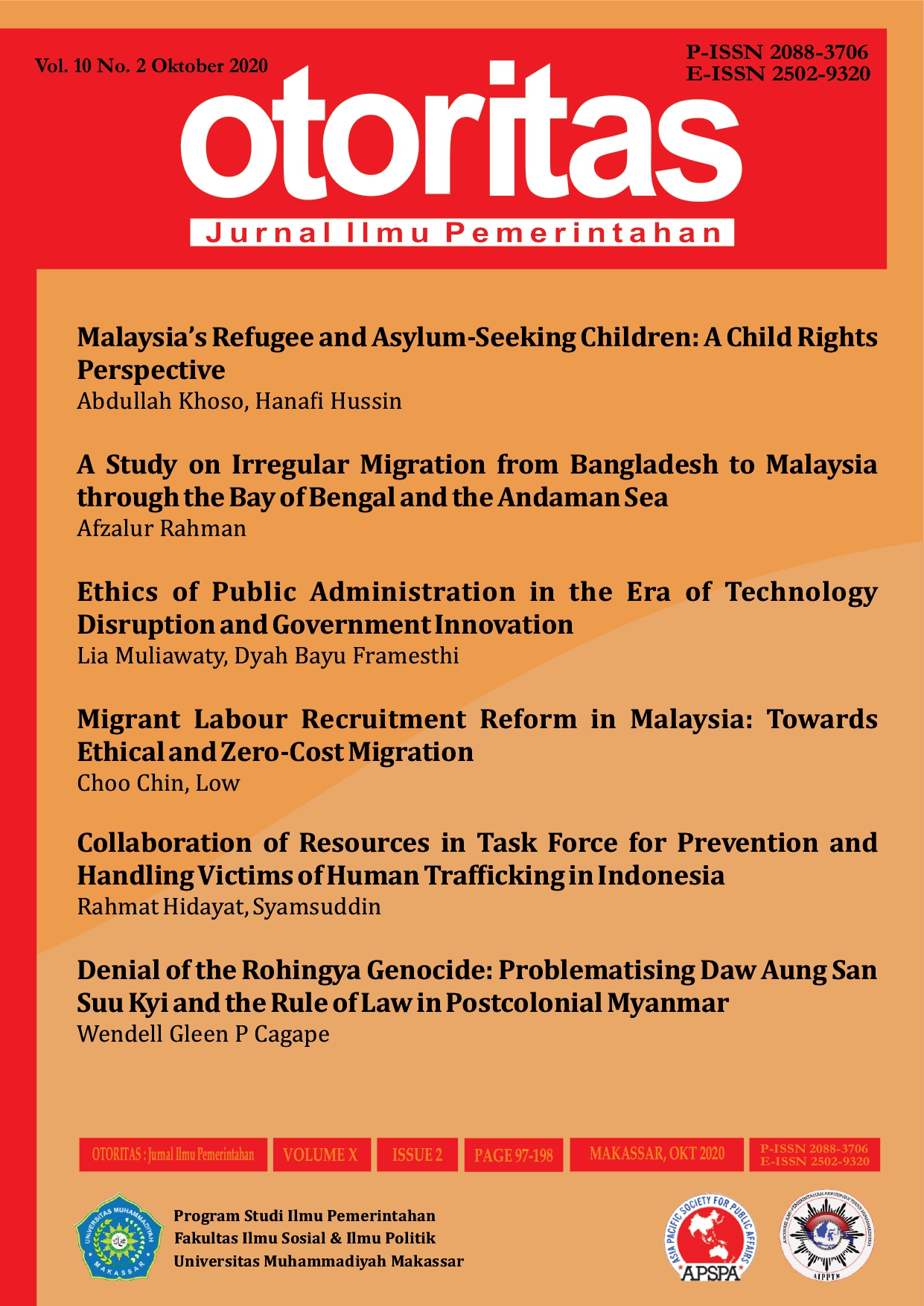A Study on Irregular Migration from Bangladesh to Malaysia through the Bay of Bengal and the Andaman Sea
DOI:
https://doi.org/10.26618/ojip.v10i2.4640Keywords:
Andaman Sea, Anti-Trafficking Policy, Bay of Bengal, Boat People, Irregular Migration, Trafficking VictimAbstract
Irregular migration is an issue of great concern for today’s world. There are various factors which are responsible for this conundrum. These are overpopulation, natural disaster, poverty, illiteracy, lack of employment opportunities, for a better life etc. Thus, irregular migration has been a livelihood strategy for the millions of people worldwide for the long time. Bangladesh is one of the top countries of the world in terms of sending labor migrants. Every year thousands of Bangladeshis are migrating overseas either legally or by illegal means for a better livelihood. However, in the last couple of years, total remittance flow was not satisfactory because of the diplomatic tension between Bangladesh and major migrants receiving countries. In addition, the new migrations policies of the Middle-Eastern countries which is the main destination points for Bangladeshi migrants in terms of single regions also have shrunk the scope. As a result, the number of irregular migrations from Bangladesh to Malaysia has increased. This paper attempts to unveil the key causes of irregular migration through the risky Bay of Bengal and the Andaman Sea by analysing the field data. It will focus on the case studies of the trafficking victims and their family members with focusing on why they took this dangerous path of irregular migration. It also argues for an effective mechanism to monitor the whole process of irregular migration from Bangladesh to Malaysia on an urgent basis.
References
Aronowitz, A. A. (2003), ‘‘Coalitions Against Trafficking in Human Beings in the Philippines,” United Nations Office on Drugs and Crime and the United Nations Interregional Crime and Justice Research Institute, Vienna, Austria. Available at: http://www.unodc.org/pdf/crime/human_trafficking/ coalitions_trafficking.pdf. Accessed 4 January 2019.
Aronowitz, A. A. (2009). Human Trafficking, and Human Misery: The global trade in human begins. Westport: Praeger Publishers.
Azad, A. (2019). Recruitment of migrant Workers in Bangladesh: elements of human trafficking for labor exploitation. Journal of human trafficking, 5(2), 130-150.
Bacon, D. (2008). Illegal people: How Globalization Creates Migration and Criminalises Immigrants. Boston: Beacon Press.
Betz, D. (2009). Human Trafficking in Southeast Asia: Causes and Policy Implication. Master’s Thesis, Naval Postgraduate School, California.
Bohl, K. (2010). Human trafficking as a livelihood strategy? - A case study of trafficking in women and children from Nepal to India. Master’s Thesis, Aolbrong University, Denmark.
Boyd, M., & Nowak, J. (2012). Social Networks and International Migration, in Martiniello, M., & Rath, J. (eds.). An Introduction to International Migration Studies. Amsterdam: Amsterdam University Press.
Chowdhury, A. R. (2020). An ‘un-imagined community’: the entangled genealogy of an exclusivist nationalism in Myanmar and the Rohingya refugee crisis. Social Identities, 26(5).
Khanna, T. (2020) Addressing COVID-ified maritime migration in the Bay of Bengal: the case of stateless Rohingya boat people. Australian Journal of Maritime & Ocean Affairs, 12(3).
Hasan, M. (2019). Bangladeshi ‘Boat People’: Context, Drivers and Policy Implications. South Asia Research, 39(1).
Hossain, M. I. (2020). Impacts of social remittances on economic activities: labour migration from a village of Bangladesh to Malaysia. Migration and Development, 1-18.
Heckathorn, D. D. (1997). Respondent-driven sampling: a new approach to the study of hidden populations. Social problems, 44(2).
ICDDR, B. (2001). “Trafficking of women and children in Bangladesh, an overview,” Special publication no-111. Retrieved from: https://childhub.org/en/system/tdf/library/attachments/trafficking_of_women_oct07.pdf?file=1&type=node&id=17948. Accessed on February 23, 2020.
Koser, K. (2007). International Migration: A very Short Introduction. New York: OUP.
Mahdavi, P. (2011). Gridlock: labor, migration, and human trafficking in Dubai. California: Stanford University Press.
Moretti, S. (2020). Between refugee protection and migration management: the quest for coordination between UNHCR and IOM in the Asia-Pacific region. Third World Quarterly, 1-18.
Muniandy, P., & Bonatti, V. (2014). Are migrants agents or instruments of development? The case of ‘temporary’migration in Malaysia. Journal of Ethnic and Migration Studies, 40(11).
Piore, M. J. (1979). Birds of Passage: Migrant Labour and Industrial Societies. New York: Cambridge University Press.
Rashid, S. R., & Ashraf, ASM. A. (2016). Asian Boat People and the Challenges of Migration Governance: A Source Country Perspective | Middle East Institute. https://www.mei.edu/publications/asian-boat-people-and-challenges-migration-governance-source-country-perspective
Ruhi, R. A. (2003). Human Trafficking in Bangladesh: An Overview. Asian Affairs, 25(4), 45-56.
Samers, M. (2010). Migration. London: Routledge.
Sassen, S. (1988). The Mobility of Labor and Capital. New York: Cambridge University Press.
Siddiqui, T. (2014). Irregular Bangladeshi Migrants: where is the Migration Law 2013?. The Daily Star, December 2, 2014, Dhaka.
Siddiqui, T. (2003). Migration as a livelihood strategy of the poor: the Bangladesh case. www.livelihoods.org Accessed on July 27, 2020.
Ullah, A. K. M. A. (2013). Theoretical rhetoric about migration networks: A case of a journey of Bangladeshi workers to Malaysia. International Migration, 51(3).
U.S. Department of State (2020). “Trafficking in Persons Report 2020,” Washington, D.C. Retrieved from: https://www.state.gov/trafficking-in-persons-report-2020/
Wallerstein, I. (1974). The Modern World-System: Capitalist Agriculture and the Origins of the European World-Economy in the Sixteenth Century. New York: Academic Press.
Downloads
Published
Issue
Section
License
The Editorial Team of Otoritas: Jurnal Ilmu Pemerintahan reserves the right to transfer the copyright of the article once it has been accepted and a decision has been made to publish it.
Department of Government Studies, Faculty of Social and Political Sciences, Universitas Muhammadiyah Makassar in collaboration with Muhammadiyah’s College Association of Government Studies (AIPPTM) and Asia Pacific Society for Public Affairs (APSPA) as the publisher of Otoritas: Jurnal Ilmu Pemerintahan holds the copyright of all articles published in this journal.
The Publisher holds the right to reproduce and distribute the article and author is not allowed to publish the same article published in this journal.
Statement of Authenticity and Manuscript Copyright can be downloaded: here
After filling in the statement letter, please send via e-mail: otoritas@unismuh.ac.id






